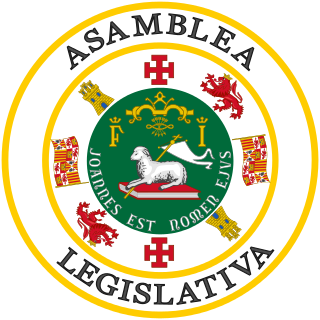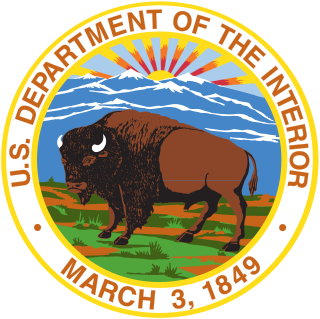
Politics of American Samoa takes place in a framework of a presidential representative democratic dependency, whereby the Governor is the head of government, and of a pluriform multi-party system. American Samoa is an unincorporated and unorganized territory of the United States, administered by the Office of Insular Affairs, U.S. Department of the Interior. Its constitution was ratified 1966 and came into effect 1967. Executive power is discharged by the governor and the lieutenant governor. Legislative power is vested in the two chambers of the legislature. The party system is a based on the United States party system. The judiciary is independent of the executive and the legislature.
In the United States, each state has its own constitution.

The Legislative Assembly of Puerto Rico is the territorial legislature of the Commonwealth of Puerto Rico, responsible for the legislative branch of the government of Puerto Rico. The Assembly is a bicameral legislature consisting of an upper house, the Senate normally composed by 27 senators, and the lower house, the House of Representatives normally composed by 51 representatives. Eleven members of each house are elected at-large rather than from a specific legislative district with all members being elected for a four-year term without term limits.

The American Samoan Legislature or Fono has two chambers, the House of Representatives and the Senate with a directly elected head of government, the Governor of American Samoa. The House of Representatives has 21 members, elected for a two-year term, 14 in single-seat districts, 6 from dual-seat districts and 1 by a public meeting on Swain Island. The Senate has 18 members, elected for a four-year term by and from the chiefs of the islands. The Governor and their deputy, the Lieutenant Governor are elected on a 4-year term.

The Constitution of the State of Connecticut is the basic governing document of the U.S. state of Connecticut. It was approved by referendum on December 14, 1965, and proclaimed by the governor as adopted on December 30. It comprises 14 articles and has been amended 31 times.
This electoral calendar 2004 lists the national/federal direct elections held in 2004 in the de jure and de facto sovereign states and their dependent territories. Referendums are included, although they are not elections. By-elections are not included.
This electoral calendar 2006 lists the national/federal direct elections held in 2006 in the de jure and de facto sovereign states and their dependent territories. Referendums are included, although they are not elections. By-elections are not included.
This electoral calendar 2007 lists the national/federal direct elections held in 2007 in the de jure and de facto sovereign states and their dependent territories. Referendums are included, although they are not elections. By-elections are not included.

The Legislature of American Samoa or Fono is the territorial legislature of American Samoa. Like most state and territorial legislatures of the United States, it is a bicameral legislature with a House of Representatives and a Senate. The legislature is located in Fagatogo along Pago Pago harbor.

The American Samoa Senate is the upper house of the American Samoa Fono. The Senate, like the lower House of Representatives, is a nonpartisan body. It is composed of 18 senators, serving a four-year term.
This electoral calendar 2008 lists the national/federal direct elections held in 2008 in the de jure and de facto sovereign states and their dependent territories. Referendums are included, even though they are not elections. By-elections are not included.

General elections was held in American Samoa on 4 November 2008, coinciding with the 2008 United States general elections.
Michigan has a republican form of government with three branches of government: the executive branch consisting of the Governor of Michigan and the other independently elected constitutional officers; the legislative branch consisting of the House of Representatives and Senate; and the judicial branch consisting of the one court of justice. The state also allows direct participation of the electorate by initiative, referendum, recall, and ratification.

Proposition 1F of 2009 was a measure approved by California voters relating to the salaries of state officers. It was an amendment of the Constitution of California prohibiting pay raises for members of the State Legislature, the Governor, and other state officials during deficit years. It was proposed by the legislature and approved in a referendum held as part of the May 19, 2009 special election ballot, in which the California electorate also voted on five other propositions.

A constitutional referendum was held in American Samoa on November 2, 2010, on the same day of the United States House of Representatives election and American Samoan general election.

A constitutional referendum was held in the Northern Mariana Islands on 2 November 2010, alongside the election for the islands' representative to the United States House of Representatives. Voters were asked whether they approved of three proposed amendments to the constitution. All three were rejected.

A series of referendums on the legislature and taxes were held in American Samoa on 3 November 1970. Voters were asked to approve a measure streamlining the spending of money obtained from taxes and duties, a ban on government employees or public officers running for the legislature while they held those positions, a measure setting the term of the Fono as two 30-day sessions per year and another capping MP salaries at six thousand dollars per year. All these measures passed and were adopted into law.

General elections were held in American Samoa on 4 November 2014, alongside a constitutional referendum. Voters elected members of the Fono and the American Samoan delegate to the United States Congress.

The 182nd New York State Legislature, consisting of the New York State Senate and the New York State Assembly, met from January 5, 1977, to December 31, 1978, during the third and fourth years of Hugh Carey's governorship, in Albany.








